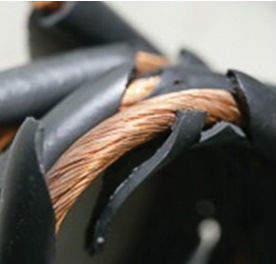Does the nuclear industry need to adopt more stringent performance criteria when it comes to assessing the design life of cable polymer insulations? By Richard Hosier

Electric cables with organic polymer insulations have a useful design life span under specific conditions.
One main cause of polymer degradation is polymer chain scission. This happens when free radicals from within or outside of the cable insulation cause breakages in the polymer backbone chain over time. This is a natural process, accelerated by heat, moisture, light, radiation and mechanical stressors. It results in degradation of mechanical performance and the multiple processes combine to increase the number of carriers in the polymer insulation material, thereby increasing conduction and ultimately leading to dielectric breakdown.
The effects of polymer ageing can be seen as both physical and electrical changes in the material properties, like reduced flexibility, deterioration of the materials’ elongation at break, hardening, cracking, surface chalking, discolouration and decreasing dielectric performance. Other operational properties may also be affected, including insulation resistance, flame retardance and oil/water resistance.
Standards
A standard widely adopted around the world to determine ageing performance for polymeric cable insulations is IEC 60216. This standard employs accelerated heat ageing of test samples, compares the aged elongation at break (EAB) performance against un-aged samples, tabulates the results on an Arrhenius plot and extrapolates to predict extended life performance.
More stringent standards are used in the aerospace industry. NASA report CR 1787 (Radiation Effects Design Handbook Sect 3. Electrical Insulating Materials) considers the useful lifespan of polymers for aerospace/space applications to be when one original property of the material (for example, tensile strength, or elongation) has changed by 25%.
For electrical cables in non-aerospace applications, we generally adopt the calculation of predicted lifespan by measuring a reduction in EAB to 50% residual (IEC 60216). EPRI also describes 50% residual EAB as a practical end-of-life threshold for cables that may be subjected to a loss-of-coolant accident (LOCA) exposure in the nuclear industry (Technical Report 1008211).
What is not often realized is that a 50% residual EAB often corresponds to a change in the material properties of 80% or more, from new. This is significantly different to NASA’s criteria of 25% for aerospace/space applications.
Given the critical importance of long-term system integrity, reliability and performance needed in the nuclear power industry it is appropriate to question if the ‘50% residual’ threshold is acceptable, or if adoption of a ‘change in property’ elongation at break would be a safer end-of-life threshold.
Today cable manufacturers blend polymers with fillers like plasticizers to improve flexibility, flame retardants to improve the fire performance, stabilizers & anti-oxidants to extend lifespan, pigments for colour and even calcined clays, zinc oxide, paraffinic waxes and oils. These additives can improve insulation and jacket material performance and slow the ageing process, but they cannot stop it.
Unfortunately all the stressors of ageing and polymer degradation are additive, so if we factor the normal combinations of cyclic heating and cooling, the occasional overload or short circuit, presence of ozone (which is often greater in coastal areas) occasional exposure to cleaning agents, oils, water, light and humidity (or even the lack of it), polymer ageing can be accelerated both considerably and unexpectedly.
Life expectations
IEC 60216 defines the temperature rating given to an insulation material as: “That temperature which degrades / reduces the material’s elongation at break (EB) to 50% absolute (residual) in a period of 20,000 hours."
Common cable insulation operating temperatures defined by IEC 60216 are:
- Polyvinyl chloride (PVC): 75°C
- Cross-linked polyethylene (XLPE): 90°C
- Chlorosulphonated polyethylene (CSP) /Ethylene Propylene Rubber (EPR): 90°C
- Silicon rubber:180°C
- Teflon (polytetrafluoroethylene): 260°C.
Perhaps what is not highlighted by these standards is that the elongation at break reduction to 50% absolute (residual) is calculated on 20,000 hours exposure time at this temperature – which is only 2.3 years.
In fact, these standards do not expect the cables to be used at these temperatures continuously. They assume usage will be on a basis of discontinuous loading. This pragmatic approach is the only way polymeric cable insulations can be economically viable.
A common ‘rule of thumb’ for polymer cable insulation ageing is that a reduction of 10°C in the average cable operating temperature across its life span will double the insulation life time to the 50% residual EAB point. Conversely, increasing the continuous exposure temperature by 10°C can halve the time to 50% residual EAB.
Of course where polymers have been formulated to have higher-temperature performance, or whose degradation is slowed by additives and special formulations, then the predicted lifespan at an anticipated mean temperature might be longer. For example, where a polymeric insulation qualifies for a 110°C temperature rating but is operated at a mean temperature of only 60°C, the 50% EAB will extrapolate out to 73.6 years (perhaps aligning with a 40 or even 60-year useful lifespan). However, this estimate may not be fully be accurate in practice because of all the other additive effects over that time of the unassessed cumulative stressors. Determining polymeric cable material temperature ratings then extrapolating expected life span as we do for non-critical domestic and commercial installations is at best questionable and could lead to potentially devastating, consequences for societies or even countries.
MICC/MIMS cables as produced today by TRM & MICC Ltd are made exclusively from inorganic materials so they do not age like polymeric cables and offer a practical alternative.
About the author
Richard Hosier represents the TRM & MICC Group and is based in Singapore. He has worked in the electrical cable industry for more than 30 years in technical and senior management positions.
